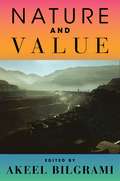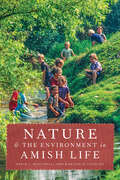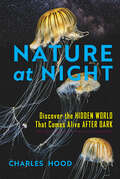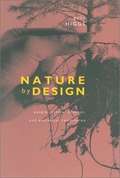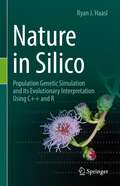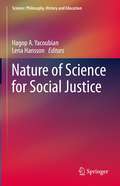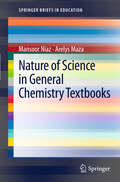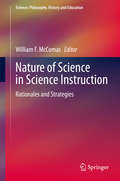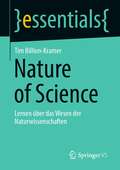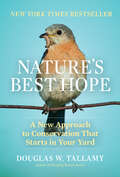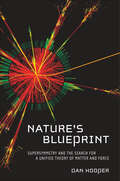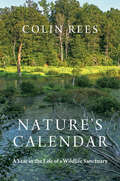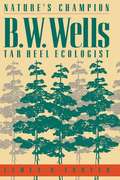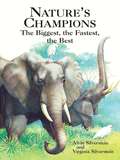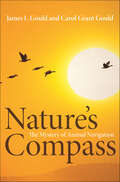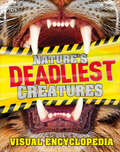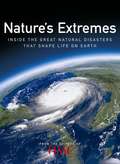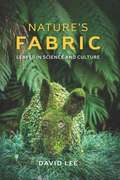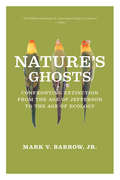- Table View
- List View
Nature and The Greeks and Science and Humanism
by Erwin SchrödingerNobel laureate Erwin Schrödinger was one of the most distinguished scientists and philosophers of the twentieth century, and his lectures are legendary. Here the texts of two of Schrödinger's most famous lecture series are made available again. In the first, entitled "Nature and the Greeks," Schrödinger offers a historical account of the scientific world picture. In the second, called "Science and Humanism," he addresses fundamental questions about the link between scientific and spiritual matters. As Roger Penrose confirms, these are the profound thoughts of a great mind, and as relevant today as when they were first published in the 1950s.
Nature and Treatment of Stuttering
by Richard F. Curlee William H. PerkinsDoctors Richard E. Curlee and William H Perkins delve into the causes of stuttering and suggest tips to deal with stuttering.
Nature and Value
by Jonathan Schell Jedediah Purdy Nikolas Kompridis David Bromwich Carol Rovane Joanna Picciotto Robert Pollin Sanjay Reddy Jan Zalasiewicz Bina Gogineni Anthony Laden Kyle Nichols James Hamilton TullyToday, as we confront an unprecedented environmental crisis of our own making, it is more urgent than ever to consider the notion of nature and our place within it. This book brings together essays that individually and as a whole present a detailed and rigorous multidisciplinary exploration of the concept of nature and its wider ethical and political implications.A distinguished list of scholars take up a broad range of questions regarding the relations between the human subject and its natural environment: when and how the concept of nature gave way to the concept of natural resources; the genealogy of the concept of nature through political economy, theology, and modern science; the idea of the Anthropocene; the prospects for green growth; and the deep alienation of human beings in the modern period from both nature and each other. By engaging with a wide range of scholarship, they ultimately converge on a common outlook that is both capacious and original. The essays together present a revaluation of the natural world that seeks to reshape political and ethical ideals and practice with a view to addressing some of the fundamental concerns of our time.Nature and Value features widely known scholars in a broad swath of disciplines, ranging from philosophy, politics, and political economy to geology, law, literature, and psychology. They include Jonathan Schell, David Bromwich, James Tully, Jedediah Purdy, Robert Pollin, Jan Zalasiewicz, Carol Rovane, Sanjay Reddy, Joanna Picciotto, Anthony Laden, Nikolas Kompridis, Bina Gogineni, Kyle Nichols, and the editor, Akeel Bilgrami.
Nature and the Environment in Amish Life (Young Center Books in Anabaptist and Pietist Studies)
by David L. McConnell Marilyn D. LovelessThe Amish relationship to the environment is much more complicated than you might think.The pastoral image of Amish communities living simply and in touch with the land strikes a deep chord with many Americans. Environmentalists have lauded the Amish as iconic models for a way of life that is local, self-sufficient, and in harmony with nature. But the Amish themselves do not always embrace their ecological reputation, and critics have long questioned the portrayal of the Amish as models of environmental stewardship.In Nature and the Environment in Amish Life, David L. McConnell and Marilyn D. Loveless examine how this prevailing notion of the environmentally conscious Amish fits with the changing realities of their lives. Drawing on 150 interviews conducted over the course of 7 years, as well as a survey of household resource use among Amish and non-Amish people, they explore how the Amish understand nature in their daily lives and how their actions impact the natural world. Arguing that there is considerable diversity in Amish engagements with nature at home, at school, at work, and outdoors, McConnell and Loveless show how the Amish response to regional and global environmental issues, such as watershed pollution and climate change, reveals their deep skepticism of environmentalists. They also demonstrate that Amish households are not uniformly lower in resource use compared to their rural, non-Amish neighbors, though aspects of their home economy are relatively self-sufficient.The first comprehensive study of Amish understandings of the natural world, this compelling book complicates the image of the Amish and provides a more realistic understanding of the Amish relationship with the environment.
Nature at Night: Discover the Hidden World That Comes Alive after Dark
by Charles HoodA new world awakens in the dark, filled with spectacular bioluminescence, moon-kissed flora, and diverse wildlife—all captured in this spectacular photography book. While old tales warn us that danger lies waiting in the dark, there is actually an abundance of thriving, colorful life. Solar winds brighten the sky with Northern and Southern Lights. In the desert, elegant datura blooms at night, enticing moths to help with pollination, while in the Rockies grizzly bears make a meal of the insects to sustain them during hibernation. In the ocean, night-feeding dolphins chase nocturnal squid which have made a vertical migration to the surface. In the jungles, jaguars hunt by moonlight while night monkeys swing safely through the trees. Experienced naturalist and photographer Charles Hood captures it all, sharing his nocturnal adventures all over the world, with insight, wit, and over 240 stunning photographs. Open your senses to this darkened world, which is strange yet familiar—and more beautiful than you ever imagined.
Nature by Design: People, Natural Process, and Ecological Restoration
by Eric S. HiggsEcological restoration is the process of repairing human damage to ecosystems. It involves reintroducing missing plants and animals, eliminating hazardous substances, and returning natural processes to places that thrive on their regular occurrence.
Nature in Silico: Population Genetic Simulation and its Evolutionary Interpretation Using C++ and R
by Ryan J. HaaslDramatic advances in computing power enable simulation of DNA sequences generated by complex microevolutionary scenarios that include mutation, population structure, natural selection, meiotic recombination, demographic change, and explicit spatial geographies. Although retrospective, coalescent simulation is computationally efficient—and covered here—the primary focus of this book is forward-in-time simulation, which frees us to simulate a wider variety of realistic microevolutionary models. The book walks the reader through the development of a forward-in-time evolutionary simulator dubbed FORward Time simUlatioN Application (FORTUNA). The capacity of FORTUNA grows with each chapter through the addition of a new evolutionary factor to its code. Each chapter also reviews the relevant theory and links simulation results to key evolutionary insights. The book addresses visualization of results through development of R code and reference to more than 100 figures. All code discussed in the book is freely available, which the reader may use directly or modify to better suit his or her own research needs. Advanced undergraduate students, graduate students, and professional researchers will all benefit from this introduction to the increasingly important skill of population genetic simulation.
Nature of Science for Social Justice (Science: Philosophy, History and Education)
by Hagop A. Yacoubian Lena HanssonThis edited volume brings closer two contemporary science education research areas: Nature of Science (NOS) and Social Justice (SJ). It starts a dialogue on the characteristics of NOS for SJ with the purpose of advancing the existing discussion and creating new avenues for research. Using a variety of approaches and perspectives, the authors of the different chapters engage in a dialogue on the construct of NOS for SJ, its characteristics, as well as ways of addressing it in science classrooms. Issues addressed are related to why a school science aiming at SJ should address NOS; what NOS-related content, skills and attitudes form the basis when aiming at SJ; and how school science can address NOS for SJ. Through a set of theoretical and empirical chapters, the authors suggest answers, but they also pose new questions on what NOS for SJ can mean, and what issues need to be taken into consideration in future research and practice.
Nature of Science in General Chemistry Textbooks
by Arelys Maza Mansoor NiazResearch in science education has recognized the importance of history and philosophy of science (HPS). Nature of science (NOS) is considered to be an essential part of HPS with important implications for teaching science. The role played by textbooks in developing students' informed conceptions of NOS has been a source of considerable interest for science educators. In some parts of the world, textbooks become the curriculum and determine to a great extent what is taught and learned in the classroom. Given this background and interest, this monograph has evaluated NOS in university level general chemistry textbooks published in U.S.A. Most textbooks in this study provided little insight with respect to the nine criteria used for evaluating NOS. Some of the textbooks, however, inevitably refer to HPS and thus provide guidelines for future textbooks. A few of the textbooks go into considerable detail to present the atomic models of Dalton, Thomson, Rutherford, Bohr and wave mechanical to illustrate the tentative nature of scientific theories --- an important NOS aspect. These results lead to the question: Are we teaching science as practiced by scientists? An answer to this question can help us to understand the importance of NOS, by providing students an HPS-based environment, so that they too (just like the scientists) feel the thrill and excitement of discovering new things. This monograph provides students and teachers guidelines for introducing various aspects of NOS, based on historical episodes.
Nature of Science in Science Instruction: Rationales and Strategies (Science: Philosophy, History and Education)
by William F. McComasThis book offers a comprehensive introduction to Nature of Science (NOS), one of the most important aspects of science teaching and learning, and includes tested strategies for teaching aspects of the NOS in a variety of instructional settings. In line with the recommendations in the field to include NOS in all plans for science instruction, the book provides an accessible resource of background information on NOS, rationales for teaching these targeted NOS aspects, and – most importantly – how to teach about the nature of science in specific instructional contexts. The first section examines the why and what of NOS, its nature, and what research says about how to teach NOS in science settings. The second section focuses on extending knowledge about NOS to question of scientific method, theory-laden observation, the role of experiments and observations and distinctions between science, engineering and technology. The dominant theme of the remainder of the book is a focus on teaching aspects of NOS applicable to a wide variety of instructional environments.
Nature of Science: Lernen über das Wesen der Naturwissenschaften (essentials)
by Tim Billion-KramerIn naturwissenschaftlich und technisch geprägten Gesellschaften gilt ein angemessenes Wissenschaftsverständnis als wichtiger Teil von Allgemeinbildung und Scientific Literacy. Es wird in der Naturwissenschaftsdidaktik als Nature of Science (NOS) diskutiert und gelehrt. Dieses essential skizziert Nature of Science-Konzeptualisierungen mit ihren Stärken und Schwächen. Im Focus steht sowohl ein klassischer Minimalkonsens als auch alternative Ansätze. Außerdem werden zentrale Befunde empirischer Forschung und Bedingungen gelingenden Lernens zu Nature of Science dargestellt. Praxisideen sowie Hinweise zur vertiefenden Literatur runden dieses essential ab.
Nature through Time: Virtual field trips through the Nature of the past (Springer Textbooks in Earth Sciences, Geography and Environment)
by Edoardo Martinetto Emanuel Tschopp Robert A. GastaldoThis book simulates a historical walk through nature, teaching readers about the biodiversity on Earth in various eras with a focus on past terrestrial environments. Geared towards a student audience, using simple terms and avoiding long complex explanations, the book discusses the plants and animals that lived on land, the evolution of natural systems, and how these biological systems changed over time in geological and paleontological contexts. With easy-to-understand and scientifically accurate and up-to-date information, readers will be guided through major biological events from the Earth's past. The topics in the book represent a broad paleoenvironmental spectrum of interests and educational modules, allowing for virtual visits to rich geological times. Eras and events that are discussed include, but are not limited to, the much varied Quaternary environments, the evolution of plants and animals during the Cenozoic, the rise of angiosperms, vertebrate evolution and ecosystems in the Mesozoic, the Permian mass extinction, the late Paleozoic glaciation, and the origin of the first trees and land plants in the Devonian-Ordovician. With state-of-the art expert scientific instruction on these topics and up-to-date and scientifically accurate illustrations, this book can serve as an international course for students, teachers, and other interested individuals.
Nature's Best Hope: A New Approach to Conservation that Starts in Your Yard
by Douglas W. Tallamy&“Tallamy lays out all you need to know to participate in one of the great conservation projects of our time. Read it and get started!&” —Elizabeth Kolbert, Pulitzer Prize-winning author of The Sixth Extinction Douglas W. Tallamy&’s first book, Bringing Nature Home, awakened thousands of readers to an urgent situation: wildlife populations are in decline because the native plants they depend on are fast disappearing. His solution? Plant more natives. In this new book, Tallamy takes the next step and outlines his vision for a grassroots approach to conservation. Nature&’s Best Hope shows how homeowners everywhere can turn their yards into conservation corridors that provide wildlife habitats. Because this approach relies on the initiatives of private individuals, it is immune from the whims of government policy. Even more important, it&’s practical, effective, and easy—you will walk away with specific suggestions you can incorporate into your own yard. If you&’re concerned about doing something good for the environment, Nature&’s Best Hope is the blueprint you need. By acting now, you can help preserve our precious wildlife—and the planet—for future generations.
Nature's Blueprint: Supersymmetry and the Search for a Unified Theory of Matter and Force
by Dan HooperThe first accessible book on a theory of physics that explains the relationship between the particles and forces that make up our universe. For decades, physicists have been fascinated with the possibility that two seemingly independent aspects of our world—matter and force—may in fact be intimately connected and inseparable facets of nature. This idea, known as supersymmetry, is considered by many physicists to be one of the most beautiful and elegant theories ever conceived. According to this theory, however, there is much more to our universe than we have witnessed thus far. In particular, supersymmetry predicts that for each type of particle there must also exist others, called superpartners. To the frustration of many particle physicists, no such superpartner particles have ever been observed. As the world&’s most powerful particle accelerator—the Large Hadron Collider—begins operating in 2008, this may be about to change. By discovering the forms of matter predicted by supersymmetry, this incredible machine is set to transform our current understanding of the universe&’s laws and structure, and overturn the way that we think about matter, force, space, and time. Nature&’s Blueprint explores the reasons why supersymmetry is so integral to how we understand our world and describes the incredible machines used in the search for it. In an engaging and accessible style, it gives readers a glimpse into the symmetries, patterns, and very structure behind the universe and its laws. &“As the world&’s most powerful particle accelerator revs up, Dan Hooper&’s book is essential reading.&” —New Scientist &“[An] energetic exploration of modern physics.&” —Kirkus Reviews
Nature's Calendar: A Year in the Life of a Wildlife Sanctuary
by Colin ReesTake an enchanting journey through the shifting seasons in a wildlife sanctuary home to wetland, forest, and grassland and supporting an incredible diversity of plants and animals.Flocks of waterfowl exploding into steely skies above frozen marshland, salamanders creeping across the forest floor to vernal pools, chorusing frogs peeping their ecstasy while warblers crowd budding trees, turtles sunning on floating logs, the ecological engineering of beavers—these are but a few of the sights and sounds marking a year at Jug Bay Wetlands Sanctuary and its neighboring landscapes in Southern Maryland. In an absorbing account of a year in the life of this sanctuary, naturalist Colin Rees invites us to join him as he explores the secrets and wonders of the changing natural world. Alongside the author, we witness spring's avian migrations, quickening of aquatic vegetation, burgeoning of myriad invertebrates, and the assaults of extreme weather conditions. We revel in summertime's proliferation of fish, fowl, and mammals. We become attuned to the shifting climate's impacts on autumnal transitions, and we marvel at amazing feats of biological inventiveness in preparation for winter conditions. Through these visions of the fleeting—and yet enduring—cycles of nature, Rees shares deep insights into the ecological and behavioral dynamics of the natural environment. Enhanced by more than two dozen color plates, the book touches on a wide range of issues, from microbial diversity, bird banding, and butterfly phenology to genetic diversity and habitat fragmentation. It also examines the challenges of conserving these and other natural features in the face of climate change and development pressures. Thoughtful and lyrical, Nature's Calendar speaks to all readers, scientific and lay alike. Fascinating profiles of flora and fauna celebrate the richness and complexity of a unique ecosystem, exploring the entire ecology of this dynamic and delicate area.
Nature's Champion
by James R. TroyerThrough the pioneering efforts of ecologist B. W. Wells (1884-1978), thousands of North Carolinians learned to appreciate and protect the state's diverse plant life long before ecology and conservation became popular causes. A keen observer of the natural landscape, Wells provided the first scientific descriptions in modern terms of the forces that shaped coastal communities, bogs and savannahs, the Carolina bays, pine forests, old fields, and mountain grassy balds. But the broader impact of his life lay in his championship and popularization of nature. Outside academic circles, he shared his knowledge through public lectures, articles, and lobbying efforts, and by teaching anyone who would listen. In 1932 he produced for his Tar Heel audience a revolutionary work on the plant ecology of the state, The Natural Gardens of North Carolina. Organized by habitat, this volume is still entertaining and instructive. Wells received his Ph.D. in botany from the University of Chicago in 1917 and served as chair of the North Carolina State College botany department for thirty years. He was a memorable teacher and a significant force in the development of his academic institution.
Nature's Champions: The Biggest, the Fastest, the Best (Dover Children's Science Books)
by Alvin Silverstein Virginia SilversteinFascinating profiles of 29 of the world's most remarkable species of animal and plant life. Simple enough for young readers, this book abounds with intriguing information that will also captivate adults. Included are astonishing facts and illustrations of the world's fastest runner, the best jumper, and other natural wonders. 50 illustrations.
Nature's Compass: The Mystery of Animal Navigation (Science Essentials #16)
by James L. Gould Carol Grant GouldThe mysterious and remarkable ways that animals navigateWe know that animals cross miles of water, land, and sky with pinpoint precision on a daily basis. But it is only in recent years that scientists have learned how these astounding feats of navigation are actually accomplished. With colorful and thorough detail, Nature's Compass explores the remarkable methods by which animals find their way both near home and around the globe. Noted biologist James Gould and popular science writer Carol Gould delve into the elegant strategies and fail-safe backup systems, the invisible sensitivities and mysterious forces, and incredible mental abilities used by familiar and rare species, as they investigate a multitude of navigation strategies, from the simple to the astonishing.The Goulds discuss how animals navigate, without instruments and training, at a level far beyond human talents. They explain how animals measure time and show how the fragile monarch butterfly employs an internal clock, calendar, compass, and map to commence and measure the two-thousand-mile annual journey to Mexico—all with a brain that weighs only a few thousandths of an ounce. They look at honey bees and how they rely on the sun and mental maps to locate landmarks such as nests and flowers. And they examine whether long-distance migrants, such as the homing pigeon, depend on a global positioning system to let them know where they are. Ultimately, the authors ask if the disruption of migratory paths through habitat destruction and global warming is affecting and endangering animal species.Providing a comprehensive picture of animal navigation and migration, Nature's Compass decodes the mysteries of this extraordinary aspect of natural behavior.
Nature's Deadliest Creatures Visual Encyclopedia (DK Children's Visual Encyclopedias)
by DKCome face-to-face with 150 of the world's scariest killer creatures, from the lion and great white shark to the tarantula, anaconda snake, golden eagle, vampire bat, and even the fierce ant!The book profiles every kind of animal--mammals, reptiles, birds, fish, insects, and arachnids. Chapters are arranged according to how these dangerous predators kill. Do they use jaws and claws, venom, stings, traps, tricks and cunning, or mass invasion?With more than 200 spectacular photos in the book, every page has a stunning image of the animal in action, with data files giving a visual guide to its size, distribution, diet, and habitat, as well as a rating of its "scare factor."Each profile features bite-size text that will appeal to all readers. Discover key facts about how the animal lives (is it solitary or a pack animal?), intriguing anatomy (the platypus is famously one of the few venomous mammals, but did you know that the venom comes from the hind leg on the males only?), and of course, their method of attack (such as chasing prey to exhaustion, launching an ambush, or paralyzing with poison).Further fascinating facts can also be found in the reference section at the end of book, including deadly defense, family trees, toxins, and prehistoric deadly creatures that are no more.
Nature's Economy
by Donald WorsterNature's Economy is a wide-ranging investigation of ecology's past, first published in 1994. It traces the origins of the concept, discusses the thinkers who have shaped it, and shows how it in turn has shaped the modern perception of our place in nature. Our view of the living world is a product of culture, and the development of ecology since the eighteenth century has closely reflected society's changing concerns. Donald Worster focuses on these dramatic shifts in outlook and on the individuals whose work has expressed and influenced society's point of view. The book includes portraits of Linnaeus, Gilbert White, Darwin, Thoreau, and such key twentieth-century ecologists as Rachel Carson, Frederic Clements, Aldo Leopold, James Lovelock, and Eugene Odum.
Nature's Extremes: Inside the Great Natural Disasters That Shape Life on Earth
by Kelly KnauerThe killer tsunami of 2004 and the devastation of Hurricane Katrina remind us of the fragility of man's place on his home planet. Now Time explores the past, present and future of this unpredictable planet, tracing the rise and fall of ancient civilizations, exploring earths most extreme environments and flying with scientists into the wildest of weather systems -- a fascinating look back at the discoveries that changed the world
Nature's Fabric: Leaves in Science and Culture
by David LeeLeaves are all around us—in backyards, cascading from window boxes, even emerging from small cracks in city sidewalks given the slightest glint of sunlight. Perhaps because they are everywhere, it’s easy to overlook the humble leaf, but a close look at them provides one of the most enjoyable ways to connect with the natural world. A lush, incredibly informative tribute to the leaf, Nature’s Fabric offers an introduction to the science of leaves, weaving biology and chemistry with the history of the deep connection we feel with all things growing and green. Leaves come in a staggering variety of textures and shapes: they can be smooth or rough, their edges smooth, lobed, or with tiny teeth. They have adapted to their environments in remarkable, often stunningly beautiful ways—from the leaves of carnivorous plants, which have tiny “trigger hairs” that signal the trap to close, to the impressive defense strategies some leaves have evolved to reduce their consumption. (Recent studies suggest, for example, that some plants can detect chewing vibrations and mobilize potent chemical defenses.) In many cases, we’ve learned from the extraordinary adaptations of leaves, such as the invention of new self-cleaning surfaces inspired by the slippery coating found on leaves. But we owe much more to leaves, and Lee also calls our attention back to the fact that that our very lives—and the lives of all on the planet—depend on them. Not only is foliage is the ultimate source of food for every living thing on land, its capacity to cycle carbon dioxide and oxygen can be considered among evolution’s most important achievements—and one that is critical in mitigating global climate change. Taking readers through major topics like these while not losing sight of the small wonders of nature we see every day—if you’d like to identify a favorite leaf, Lee’s glossary of leaf characteristics means you won’t be left out on a limb—Nature’s Fabric is eminently readable and full of intriguing research, sure to enhance your appreciation for these extraordinary green machines.
Nature's Frontiers: Achieving Sustainability, Efficiency, and Prosperity with Natural Capital (Environment and Sustainable Development)
by Jeffrey Smith Richard Damania James Gerber Peter Hawthorne Stephen Polasky Fabian Wagner Russ Mary Ruckelshaus Rebecca Chaplin-Kramer Martin Philipp Heger Saleh Mamun Giovanni Ruta Rafael Schmitt Adrian VoglThe great expansion of economic activity since the end of World War II has caused an unprecedented rise in living standards, but it has also caused rapid changes in earth systems. Nearly all types of natural capital—the world’s stock of resources and services provided by nature—are in decline. Clean air, abundant and clean water, fertile soils, productive fisheries, dense forests, and healthy oceans are critical for healthy lives and healthy economies. Mounting pressures, however, suggest that the trend of declining natural capital may cast a long shadow into the future. Nature’s Frontiers: Achieving Sustainability, Efficiency, and Prosperity with Natural Capital presents a novel approach to address these foundational challenges of sustainability. A methodology combining innovative science, new data sources, and cutting-edge biophysical and economic models builds sustainable resource efficiency frontiers to assess how countries can sustainably use their natural capital more efficiently. The analysis provides recommendations on how countries can better use their natural capital to achieve their economic and environ mental goals. The report indicates that significant efficiency gaps exist in nearly every country. Closing these gaps can address many of the world’s pressing economic and environmental problems—economic productivity, health, food and water security, and climate change. Although the approach outlined in this report will entail demanding policy reforms, the costs of inaction will be far higher.
Nature's Ghosts: Confronting Extinction from the Age of Jefferson to the Age of Ecology
by Mark V. Barrow Jr.A historical narrative of endangered animals and the dedicated individuals who have studied and struggled to protect them, offering an unprecedented view of what we've lost and a stark reminder of the hard work of preservation still ahead.
Nature's Ghosts: Confronting Extinction from the Age of Jefferson to the Age of Ecology
by Mark V. Barrow Jr.The rapid growth of the American environmental movement in recent decades obscures the fact that long before the first Earth Day and the passage of the Endangered Species Act, naturalists and concerned citizens recognized—and worried about—the problem of human-caused extinction.As Mark V. Barrow reveals in Nature’s Ghosts, the threat of species loss has haunted Americans since the early days of the republic. From Thomas Jefferson’s day—when the fossil remains of such fantastic lost animals as the mastodon and the woolly mammoth were first reconstructed—through the pioneering conservation efforts of early naturalists like John James Audubon and John Muir, Barrow shows how Americans came to understand that it was not only possible for entire species to die out, but that humans themselves could be responsible for their extinction. With the destruction of the passenger pigeon and the precipitous decline of the bison, professional scientists and wildlife enthusiasts alike began to understand that even very common species were not safe from the juggernaut of modern, industrial society. That realization spawned public education and legislative campaigns that laid the foundation for the modern environmental movement and the preservation of such iconic creatures as the bald eagle, the California condor, and the whooping crane.A sweeping, beautifully illustrated historical narrative that unites the fascinating stories of endangered animals and the dedicated individuals who have studied and struggled to protect them, Nature’s Ghosts offers an unprecedented view of what we’ve lost—and a stark reminder of the hard work of preservation still ahead.

